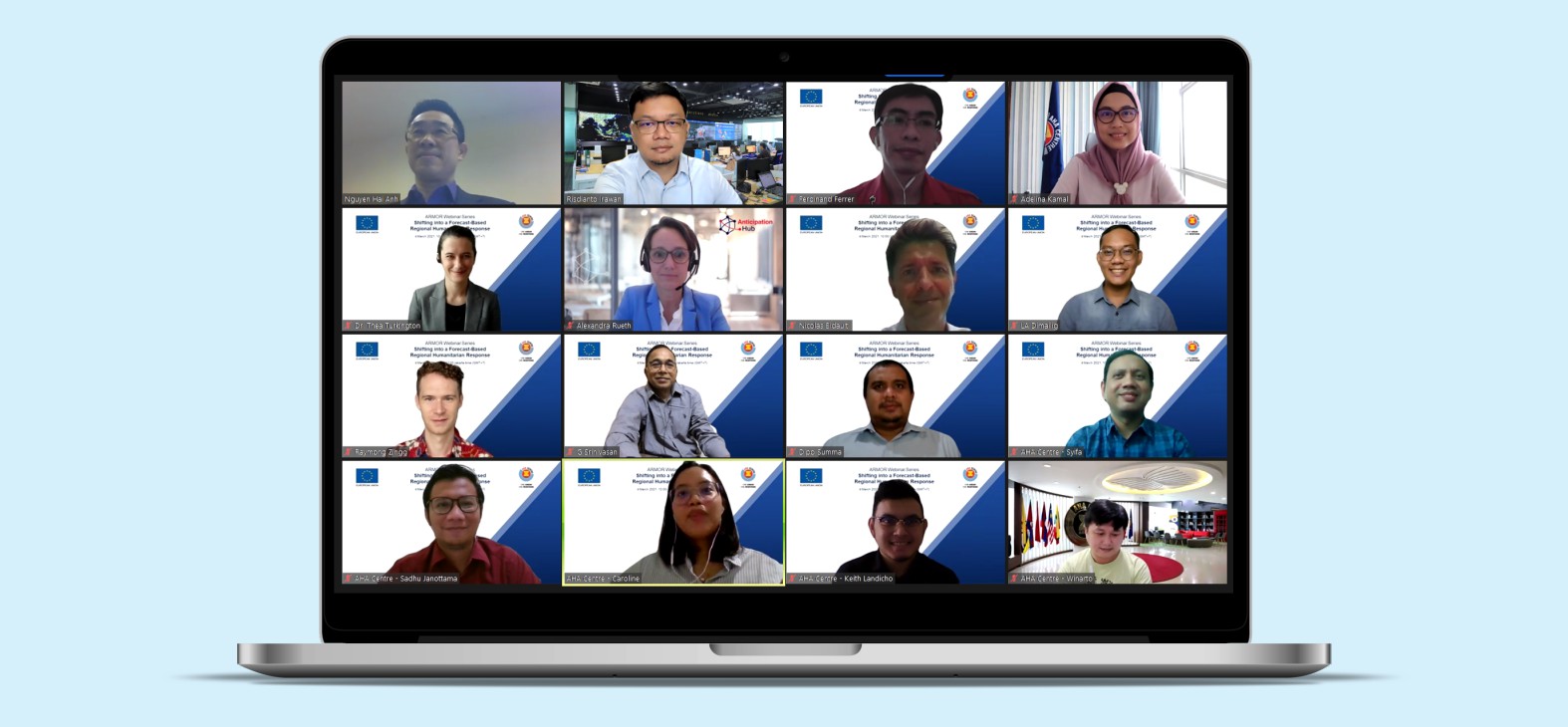
ARMOR WEBINAR SERIES #3:
SHIFTING INTO A FORECAST-BASED REGIONAL HUMANITARIAN RESPONSE
The third instalment of the ASEAN Risk Monitor and Disaster Management Review (ARMOR) Webinar Series focused on the topic of ‘Shifting into a Forecast-based Regional Humanitarian Response’. The webinar series is being implemented to discuss articles presented by the ARMOR 2nd Edition, with this session aiming to highlight the importance of anticipatory action in disaster management. The webinar engaged various experts and commentators from different international organisations, and was conducted in a virtual environment on 4 March 2021.
The webinar began with a discussion on the article titled When Early Actions Save Lives: Anticipating Instead of Reacting with Forecast-based Financing. Panellists in this session spoke about how Forecast-based Financing (FbF) strengthens humanitarian mandates by enabling National Societies to assist people in need more quickly and effectively. They also discussed about internal processes in becoming more agile in delivering aid and services under FbF, and the emergency response processes profiting equally – which means that FbF also contributes to the enhancement of responses.
The three panellists for the session were Mr Raymond Zingg (Regional Forecast-based Financing Coordinator for Asia Pacific of the IFRC), Mr Nguyen Hai Anh (Vice President and Secretary-General of the Viet Nam Red Cross Society), and Mr Ferdinand Ferrer (Philippine Red Cross Chapter Administrator of Camarines Norte). Mr Anh provided an example of FbF implementation in Viet Nam for heatwaves in an urban context, with the main objective of reducing the impact of heatwaves on Hanoi’s most vulnerable populations. As each heatwave can affect a large area, the organisations recognised the need to identify the most at-risk zones. Mr Ferrer shared lessons learned on developing an Early Action Protocol (EAP) for tropical cyclones in the Philippines, as the Philippine Red Cross (PRC) developed an EAP that enables the implementation of early actions focusing on the most at-risk municipalities. The EAP adapts to the local contexts of these municipalities by encouraging the strengthening of vulnerable houses, early harvesting of mature crops, and evacuation of livestock.
The second ARMOR article up for discussion was Three Weeks’ Notice: Forecasting Extreme Weather Events with Subseasonal-to-Seasonal Climate Prediction, which engaged Dr Govindarajalu Srinivasan (Chief Scientist for Climate Applications, Regional Integrated Multi-Hazard Early Warning System for Africa and Asia – RIMES), and Dr Thea Turkington (Senior Research Scientist in the Seasonal and Sub-seasonal Prediction Section, Meteorological Service Singapore). The panellists discussed the importance of considering Subseasonal-to-Seasonal (S2S) predictions as part of a broader spectrum of weather and climate products that should be utilised together to improve decision-making in the areas of preparedness and response.
Such easy-to-use decision support systems that bring together a range of weather and climate information will better enable disaster managers to put S2S into action. It was also explained that successful integration of S2S into disaster preparedness protocols can reduce disaster impacts, because the predictions from S2S have a higher update frequency than seasonal predictions, as well as longer lead time than short and medium-range weather forecasts.
All webinar participants also had the opportunity to have an interactive session with the expert panellists and commentators. Interestingly, discussing the issues related to anticipatory decision-making saw most participants agree that anticipatory action implementation also needs to be supported by the policy makers and governments. In line with this context, an announcement was also made at the beginning of the webinar related to the AHA Centre’s new collaboration with the Anticipation Hub. Ms Adelina Kamal, the Executive Director of the AHA Centre, stated that this collaboration will enable more anticipatory action across the region.
Different perspectives on both articles were provided during the event, with guest commentary offered by Alexandra Ruth (Head of the Anticipation Hub from the German Red Cross), and Nicolas Bidault (Head of Vulnerability Analysis and Mapping, UN World Food Programme Regional Bureau for Asia and the Pacific). The ARMOR Webinar Series was organised as part of the EU-SAHA project, through the support of the European Union Mission to ASEAN.
Written by: Moch Syifa | Photo Credit : AHA Centre




